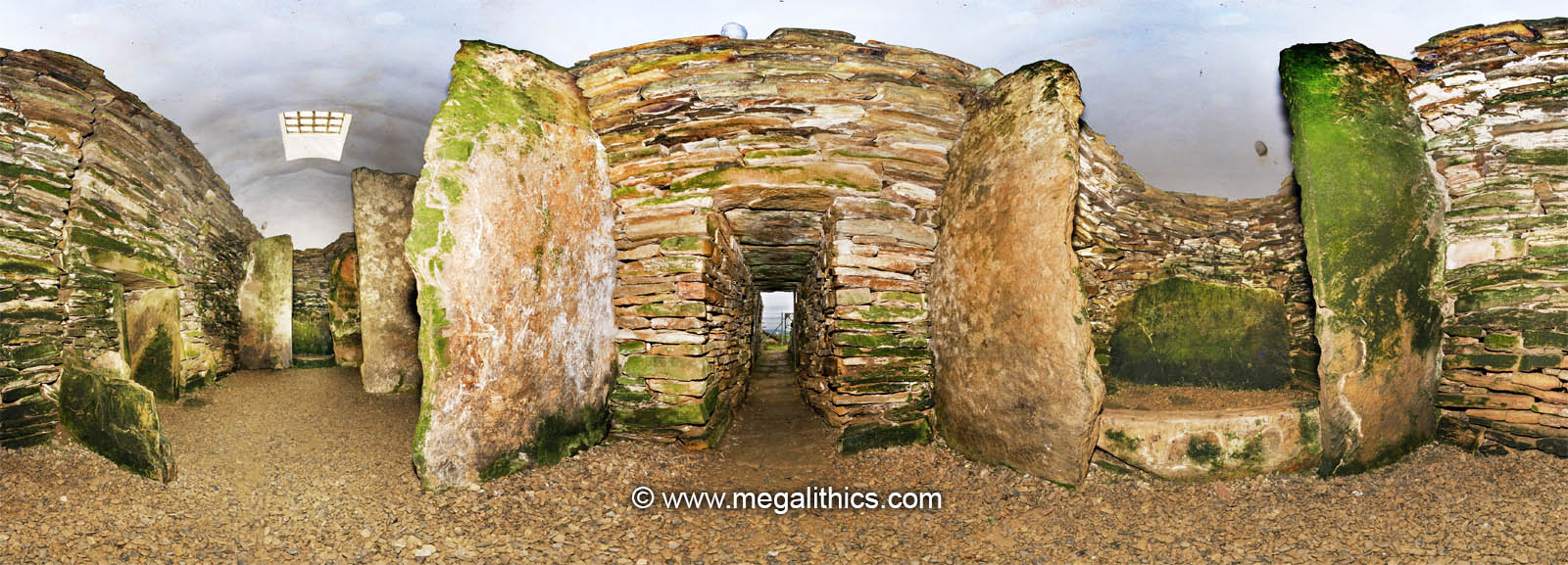 |
| HY 28291 11713 (GPS 37min) southern skylight. | Cairn 13.7m x13.0m (Pub). |
| Visited June 2008 | Alt.14m OD (GPS.) |
 |
Unstan also called Onstan (ORK 51 ), is an Orkney-Cromarty round cairn with a stalled chamber arrangement. The cairn is situated on a promontory that juts out into the southern end of the Loch of Stenness on Orkney Mainland. The stone circles of Brodgar and Stenness, the Ring of Bookan ?henge and the Maes Howe cairn are all visible from the site.
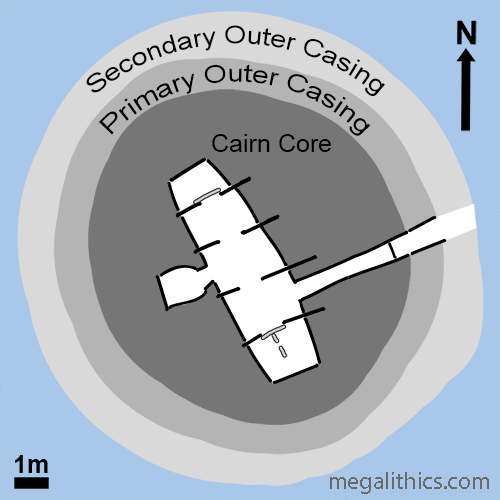
PUBLISHED ACCOUNTS
Considering the importance of the Unstan cairn there are surprisingly few publications devoted to the cairn itself in archaeological journals, indeed there are more papers dedicated to the analysis of the pottery found there. Unstan is included in many books, but these tend to be general guides to Orkney sites or prehistoric monuments in general.
Clouston (1) excavated the cairn in 1884, he found most of the entrance passage still roofed, but it seems the chamber roof had collapsed. He found human bones in every compartment of the chamber and many sherds from the now famous Unstan ware bowls.
Henshall describes Unstan in her magnum opus of 1963 (2) publishing an excellent plan and sections. Her description was later expanded in her most excellent work on the Orkney chambered cairns (3) in 1989.
DESCRIPTION
Two words you will see often in any serious description of Unstan is "unusual" and "unique". Although it is definitely an Orkney-Cromarty cairn with stalled-type chamber construction, so many of its features are unique within its class, or at least very rare.
The Cairn and Passage
Unstan is a round cairn, almost circular but stretched slightly along the line of the chamber. The cairn is unusual in that it has a structure of multiple concentric layers (see diagram above), this type of cairn construction is commonly found in cairns with Maes Howe type chambers. As far as we are aware, Unstan is the only Orkney-Cromarty cairn with this feature. Unstan is also unique in that it is the only Orkney-Cromarty cairn with a chamber of more than four compartments to occupy a round cairn. All other Orkney-Cromarty cairns with five compartments or more have elongated cairns built to reflect the shape of their chambers, perhaps the presence of the side cell, yet another very rare feature, may have influenced the cairn shape.
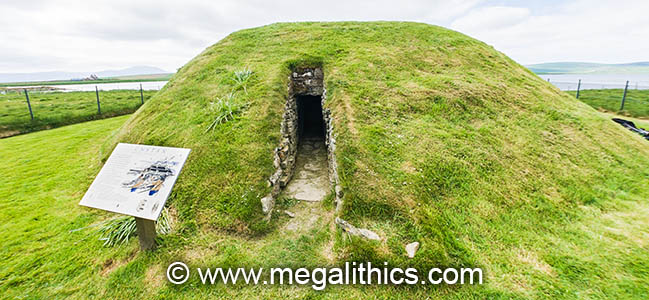
The chamber is wholly contained within the cairn core, this around 9.2m x10.3m, it is surrounded by the primary cairn casing which is about 11.2m x 12.3m, basically a layer of about a metre. The primary casing was almost as tall as the core structure. The inner two layers were surrounded the secondary cairn casing which measured about 14.0m x 13.5m, on excavation this layer was found to be much lower than the two it encircled. This may have been due to robbing, but at other cairns with this multi-layer pattern of construction (such as Quoyness), this outer layer was intentionally capped at a lower height than the inner two. The stones comprising the outer layer had been set at a slanted angle, this is thought to be a decorative feature and may mimic decorative motifs found on Unstan ware bowls.
Another unusual feature seen at Unstan is that the entrance passage enters the chamber at right angles to its main axis. In nearly all other Orkney-Cromarty cairns with stalled chambers the passage enters at one end, in line with the chamber axis, the only other Orkney-Cromarty cairn with this arrangement is Blackhammer . The passage was originally 6.5m long, but the outer section has been destroyed and only around 5.7m exists today. Even this reduced length is unique, Unstan has the longest entrance passage of any known Orkney-Cromarty cairn.
We measured the bearing along the passage as standard during our visit, it was 70 degrees true. Later, when visiting the Stenness stone circle we noticed that Unstan is clearly visible from the circle across the loch and that the passage might be aligned, so we plotted the angle to Stenness from Unstan and it is 70 degrees! It looks very much as though the Unstan entrance passage was deliberately constructed with the view to the Stenness ring in mind.
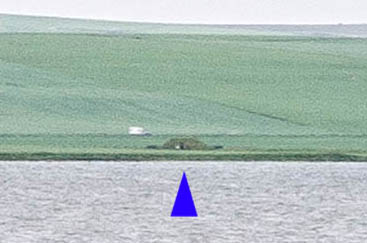
Unstan cairn viewed across the loch from the
centre of the Stenness ring.
On excavation the passage roofing survived for a length of 3m from the chamber, the lintels stones being a mixture of flat and edge-laid stones. About the same length of passage is roofed today, but the present roofing is a modern reconstruction. We could find no record of the original height of the passage roof, Clouston does not mention it, and does not provide a section in his plan. We could not stand in any of the intact cairn entrance passages on Orkney and were frequently on our knees entering, so we highly doubt that the present passage height of over two metres was original.
The multi-layer nature of the cairn construction can be viewed directly in the walls of the passage, two vertical joints in the masonry show where the components meet each other. The passage floor had a 0.2m tall slab set in it where the roofing stopped, Clouston mentions that the flooring outside of this was "rudely built up to its level". It has been suggested that this step may have been the remnants, or beginnings, of blocking. Today the passage is level and stone paved along its length, no sign of the step feature remains.
Chamber
The chamber is about 6.6m x 1.9m wide at maximum, this length is unusual in Orkney-Cromarty cairns, only six have longer chambers, and five of these are restricted to the island of Rousay.
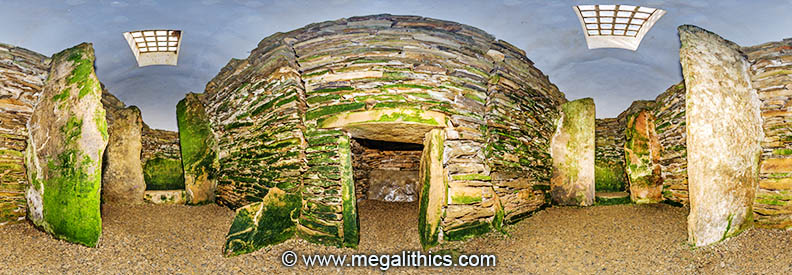
Walling survives to a height of 2.05m, but the chamber was roofless on excavation, so the original internal height is unknown. Unstan has a stalled chamber arrangement, with five compartments separated by four pairs of transverse segmenting slabs. The transverse slabs vary in height between 1.55m to 2.0m tall, although the pairs of stones appear to be of equal width, if Henshall's plan diagram is correct, the eastern stones are almost twice the width, the extra being embedded out of sight in the chamber walls. The central two segmenting slabs in the western wall are damaged, the northern one is essentially absent, only a few scraps left in its groove, the southern has a large fragment of its base surviving in its groove to about 0.3m tall. The segmenting slabs did not support, or reach the original chamber roof, as walling survives above some of them and a large walling stone projects out above the extreme SW slab.
The north and south end walls of the chamber both have a large slab set on edge and leaning outwards with walling continuing above. Both of the end compartments had sill stones 0.2-0.3m high set across the gap between the segmenting stones at their bases. Both compartments had partial stone paving and the southern one was also divided N-S by a row of edge set stones of similar height to the sill stones. Each E and W wall of both end compartments have between one and three projecting stones let into the wall at a height of about 1.2m, these are interpreted as being supports for now-vanished stone shelves that would divided each end compartment horizontally.
The middle three compartments seem to have been simple spaces with a "bay" on each side between the segmenting stones, except for the western side of the mid compartment which has an entrance to a side cell. This is another unusual feature for a stalled chamber Orkney-Cromarty cairn, the only other cairn to definitely have this feature is Isbister. As with the multi-layered cairn construction, side cells are a feature most commonly found in Maes Howe type chambers.
The side cell is entered through a portal in the chamber's west wall, the doorway is small, 0.4m wide and 0.85m tall. The cell itself is 1.45m deep and 1m wide and there is a large slab set on edge as a back stone, echoing the stones in the terminal compartments. Walls corbel in to roof stones at a height of 1.2m, Henshall (3) describes two roof lintels, one flat, and one edge set, but our photos show two set flat divided by one edge set. The present lintel stone on the doorway and the walling above this is restoration, so perhaps one of the flat roof stones is also a replacement, although Clouston does state that "Unlike the rest of the building, with the exception of the passage, the roof here is entire."
The doorway lintel is definitely a replacement, it is completely absent in a photo taken during excavation. This raises a problem as the surface of this lintel facing out into the chamber is the only definite instance of rock art in the cairn, it bears a carving of a scene featuring a diving bird and several twig runes on its southern end. If this stone is a replacement, where did it come from, and if it did originate within the cairn, was the rock art even visible in its original situation? There are many instances of decorated stones being reused as structural elements in later monuments with their carved surfaces buried and not visible, as their art had no significance to the builders.
The floor of the entire chamber was covered in white clay, only the end compartments and the side cell featured stone paving. Disarticulated human bones were found in every compartment in the chamber and all of these were unburnt despite the presence of burnt flint tools and a dark charcoal containing layer found in many areas of the floor. The side cell contained two crouched inhumations, Clouston commented on their preservation "one of the skulls being the most complete of any of those found".
The main finds in chamber were of pottery sherds, a lot of pottery sherds. The second compartment from the south, where the passage enters contained the most finds, some of the sherds found here were buried in a hole dug through the floor clay in the SW corner. It is estimated that the remains of at least 35 bowls were recovered, all were broken, and Clouston was puzzled by the way the sherds seem to have been scattered around the chamber interior "A most striking instance of how the relics must have been scattered is the fact of a piece of pottery, found in the fourth compartment, fitting into an urn, the rest of which was dug up in this second compartment of the chamber."
The pottery was nearly all of a particular type, shallow, carinated bowls with a distinctive style of incised decoration. Although bowls of this type have been found at other Orkney sites, this type of pottery is now universally known as Unstan ware. For more coverage on these finds visit our finds page.
The Unstan cairn has been consolidated and a large concrete dome has been built over it, unfortunately the dome conceals all of the external features of the cairn structure and this is now only visible in the walling of the passage. The monument is open to the public, but entry is by the original passage that is only about half a metre wide, which will be a problem for wheelchair folk. There are two large skylights in the dome, which is painted white internally, so there is usually enough natural light to enjoy the chamber structure, although if you wish to examine the interior of the side cell in detail, a torch will be necessary.
1.
Clouston, R.S.,
Proceedings of the Society of Antiquaries of
Scotland, 19, p.341-51,1884.
2.
Henshall, A. S.,
The Chambered Cairns of Scotland,
p.239-43, Edinburgh University Press, 1963,
Edinburgh.
3.
Davidson, J. L. and Henshall, A. S., The Chambered
Cairns of Orkney, p.164-7,
Edinburgh University Press, 1989, Edinburgh.